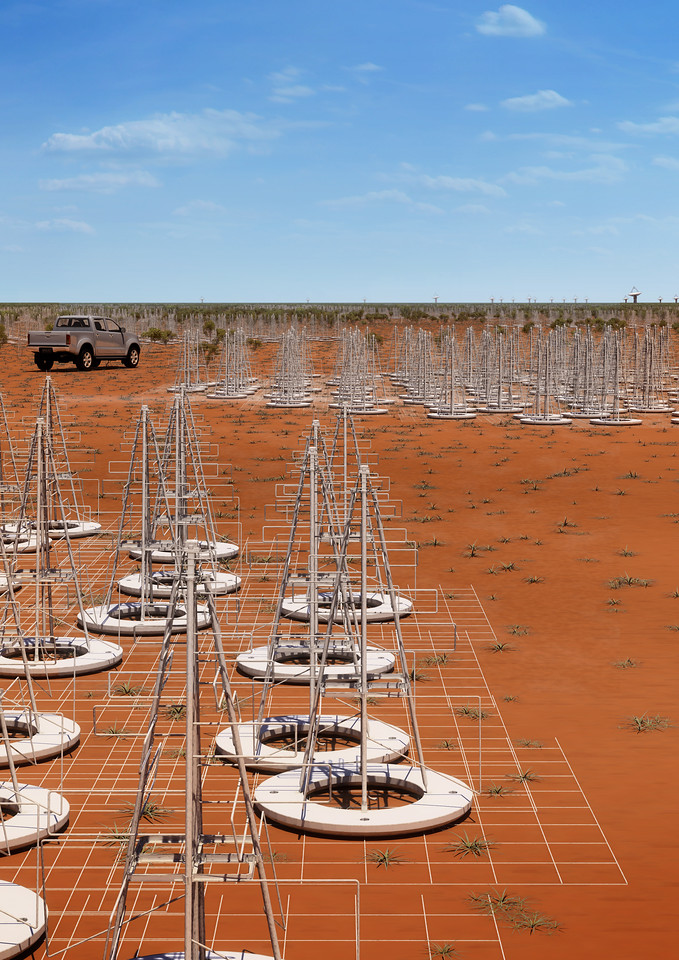Big finds expected from SKA
 Australia will soon be home to half of the most sensitive telescope ever.
Australia will soon be home to half of the most sensitive telescope ever.
The Square Kilometre Array (SKA) in Western Australia is now shovel-ready, making it a good time to look at the new place Australia is making for itself in the international space game.
The Square Kilometre Array (SKA) is a radio telescope project planned for both Australia and South Africa. It is being built in the southern hemisphere, where the view of the Milky Way Galaxy is the best and radio interference at its least.
Each country will host one of two ‘cores’, consisting of thousands of small antennae linked together by high bandwidth optical fibre. Analysis of the data collected between these two cores will be carried out at research institutes around the world.
The antennae feature extremely wide field-of-view (FOV) capabilities, so that experts can survey very large areas of sky at once. They will also rely on innovations made at CSIRO to increase the survey speed of the SKA and enable several users to observe different pieces of the sky simultaneously.
The combination of a very large FOV with high sensitivity means that the SKA will be able to compile extremely large surveys of the sky considerably faster than any other telescope. In some comparisons, the new technology runs about 50 times faster than its predecessors.
The Australian arm of the SKA is located in the nation’s first radio quiet zone, which was established by the Australian Communications and Media Authority in 2005.
The design of the SKA is based largely on previous innovations by Australian researchers, especially SKA precursor telescopes like CSIRO’s Australian SKA Pathfinder telescope (ASKAP) and Curtin University’s Murchison Widefield Array.
Based on findings from these telescopes, the SKA already has a lot of work to do.
It will be able to run extreme tests of Einstein’s theory general relativity. While the 100-year-old ideas are still a ‘theory’, they have precisely predicted the outcome of every experiment made to test them.
The SKA should be able to massively increase the scale of relativity studies, using entire pulsars as cosmic gravitational wave detectors, or timing pulsars found orbiting black holes. This should enable astronomers to examine the limits of general relativity such as the behaviour of spacetime in regions of extremely curved space.
The SKA should also make our maps of nearby galaxies much more detailed. The device is extremely sensitive to the 21 cm hydrogen line, which is a type of radiation emitted by hydrogen atoms.
Being so sensitive, experts expect SKA will map a billion galaxies out to the edge of the observable Universe, revealing the large-scale structure of the cosmos and the processes resulting in galaxy formation and evolution.
Being able to image hydrogen throughout the Universe will provide a three-dimensional picture of the first ripples of structure that formed individual galaxies and clusters. One this scale, researchers may also be able to measure the effects hypothetically caused by dark energy and the increasing rate of expansion of the universe.
The SKA is also intended to provide observational data from the cosmic Dark Ages, about 300,000 years after the Big Bang when the universe became cool enough for hydrogen to emerge, and First Light, when young galaxies formed for the first time about a billion years later.
Additionally, SKA will search for extra-terrestrial life.
It is running a science program called ‘Cradle of Life’, which will focus on three indicators of alien life: protoplanetary discs in habitable zones, prebiotic chemistry, and signs of extraterrestrial intelligence.
The SKA is designed to probe the habitable zone of Sun-like protostars, where Earth-like planets or moons are most likely to have conditions favourable for the development of life.
The SKA can also spot complex organic compounds (carbon-containing chemicals) in outer space, including amino acids.
It should be ready in the mid-2020s.







 Print
Print